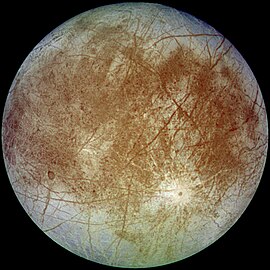Europa (corp celest)
|
Chest artícol a l'è scricc in Lumbàrt, ortograféa orientàl unificàda. |
| Europa
(Giove II)
| |
|---|---|

| |
| Satellite de | Giove |
| Descuprii | 7 gennaio 1610 |
| Descovridor | Galileo Galilei Simon Marius |
| Parameter orbital | |
| (a l'epoca J2000) | |
| Semiass maggior | 671 034 km |
| Perijovi | 664 700 km |
| Apojovi | 677 300 km |
| Circonf. orbitala | 4 216 100 km |
| Period orbital | 3,551181041 dé (3gg. 13h 13' 42") |
| Period sinodegh | 87,96935 dé (0,240847 agn) |
| Velocità orbitala | 13 613 m/s (min)
13 741 m/s (media) 13 871 m/s (max)
|
| Inclinazion su l'eclittega |
1,79° |
| Inclinazion dal equat. de Giove |
0,47° |
| Ecentricità | 0,0094 |
| Dati fisegh | |
| Diameter medi | 3 121,6 km |
| Superfiss | 3,1 × 1013 m² |
| Volum | 1,593 × 1019 m³ |
| Massa | 4,80 × 1022 kg
|
| Densità media | 3,014 × 10k |
| Acceleraz. de gravità in superfiss | 1,314 m/s² (0,134 g) |
| Velocità de fuga | 2 025 m/s |
| Period de rotazion | rotasiù sìncrona |
| Inclinazion assiala | 0.1° |
| Temperatura superficiala |
~50 K (−223 °C) (min) 103 K (−170 °C) (media) 125 K (−148 °C) (max)
|
| Pression atm. | 1 μPa |
| Albedo | 0,67 |
| Dati d'osservazion | |
| Magnituden app. | 5,3 (media)
|
| Magnituden app. | 5,29 |
Europa l'è el quart dei satèliti natürài del pianéta Giove per dimensiù e 'ntra chèi che g'ha la màsa piö grànda de töt el Sistema Solar. L'è stat scuprìt del Galileo Galilei ai 7 de zenér del 1610 ensèma a Io, Ganimede e Calisto, de alùra ciamàcc töcc ensèma "satèliti galileià" (ma apò a "satèliti medìcei").

Europa el ghe gìra entùren a Giove conden perìot de presapóch tré dé e mès (dé terèstri); el semiàs magiur de la sò òrbita l'è de 670.900 km. L'orbita l'è praticamènt circolàr condena ecentricità de 0,0094 e 'n inclinasiù de apéna 0,470° en confrónt al equatùr de Giove.[1]
Compagn de töcc i óter satèliti galileià Europa l'è en rotasiù sìncrona con Giove, conden emisfér del satèlite che 'l vàrda sèmper 'nvèrs el pianéta.[2]
Le oservasiù fàde endel 1994 per mès del spetrografo a bórt del telescòpio spasiàl Hubble le g'ha pirmitìt de stabeléser la prezènsa de 'n atmosfera, aisebé che dèbola dèbola, entùren al satèlite, cumpunìda de osìgeno.[3][4] La presiù atmosférica al leèl del teré l'è de l'ùrden del micropascàl. de töcc i satèliti del Sistema Solar, apéna amò sés (Io, Ganimede, Calisto, Titano, Encelado e Tritone) i g'ha 'na atmosféra apresàbil.
Riferimèncc
[Modifega | modifica 'l sorgent]- ↑ Europa, a Continuing Story of Discovery. NASA, Jet Propulsion Laboratory. URL consultad in data 9 agosto 2007.
- ↑ Planetographic Coordinates. Wolfram Research, 2010. URL consultad in data 2010=03-29.
- ↑ Hall, D. T. et al.; Detection of an oxygen atmosphere on Jupiter's moon Europa, Nature, Vol. 373 (23 February 1995), 677–679 (accessed 15 April 2006)
- ↑ Donald Savage; Jones, Tammy; Villard, Ray. Hubble Finds Oxygen Atmosphere on Europa. NASA, Jet Propulsion Laboratory, 23 febbraio 1995. URL consultad in data 17 agosto 2007.
Text is available under the CC BY-SA 4.0 license; additional terms may apply.
Images, videos and audio are available under their respective licenses.

